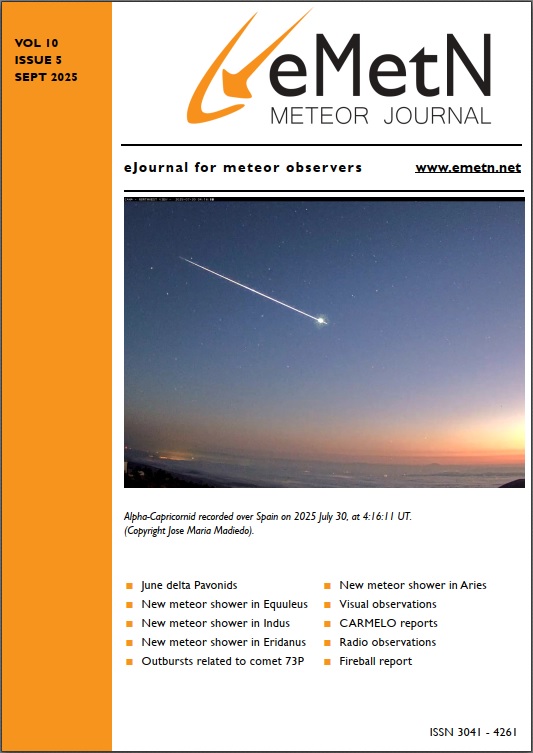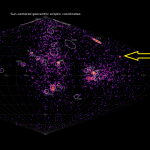By Damir Šegon, Denis Vida and Paul Roggemans
Abstract: A new meteor shower with a Mellish type comet orbit (TJ = 1.55 ± 0.18) orbit has been detected during September 3–5 by the Global Meteor Network. Meteors belonging to the new meteor shower were observed between 161° < λʘ < 163° from a radiant at R.A. = 21° and Decl.= +74° in the constellation of Cassiopeia, with a geocentric velocity of 45.5 km/s. The new meteor shower has been submitted to the IAU MDC for inclusion in the Working List of Meteor Showers.
Introduction
On 8 September 2024, Peter Jenniskens and Nick Moskovitz announced the detection of a meteor outburst from a radiant in Cassiopeia, near the star psi Cas (Jenniskens and Moskovitz, 2024a;2024b). Nine meteors of this shower had been recorded by Lowell Observatory CAMS in Arizona and four more meteors by CAMS California. These meteors were recorded during a short time interval 161.88° < λʘ < 162.14° (2024, September 4). CAMS at Lowell Observatory is equipped with RMS cameras reporting meteor data to both the Global Meteor Network and the CAMS project, allowing us to perform a detailed analysis of this shower using the same data used for discovery.
An independent confirmation of this new shower came from SonotaCo with 6 orbits recorded between 162.0° < λʘ < 162.4 (Sekiguchi, 2024). One of these meteors was recorded with a spectrum and Sekiguchi suggested asteroid 2010OA101 as a possible parent body.
The new nomenclature rules for meteor showers were approved by members of the F1 Commission by vote, which took place electronically from July 15 to July 20, 2022. However, this new shower has not been reported to the IAU MDC according to these rules. Therefore, the authors decided to submit the GMN data for inclusion into the Working list of meteor showers, for the purposes of database completion. We are leaving the priority of discovery to the original shower discoverers.
The GMN radiant plot for 161.0° < λʘ < 162.0 (September 3–4) shows a clear radiant concentration (Figure 1, top). The activity was even stronger the next night, 162.0° < λʘ < 163.0 (September 4–5) (Figure 1, bottom). The nights before or after these two nights, no trace of any active radiant appears on these plots. Meteors from this new shower were recorded on cameras in 20 countries: Belgium, Bulgaria, Canada, Croatia, Czech Republic, Denmark, Germany, Hungary, Ireland, Italy, Portugal, Romania, Russia, Slovakia, Slovenia, South Korea, Spain, the Netherlands, the United Kingdom and the USA. The meteors had an average absolute magnitude of –0.54, within a range of –3.0 to +1.5.
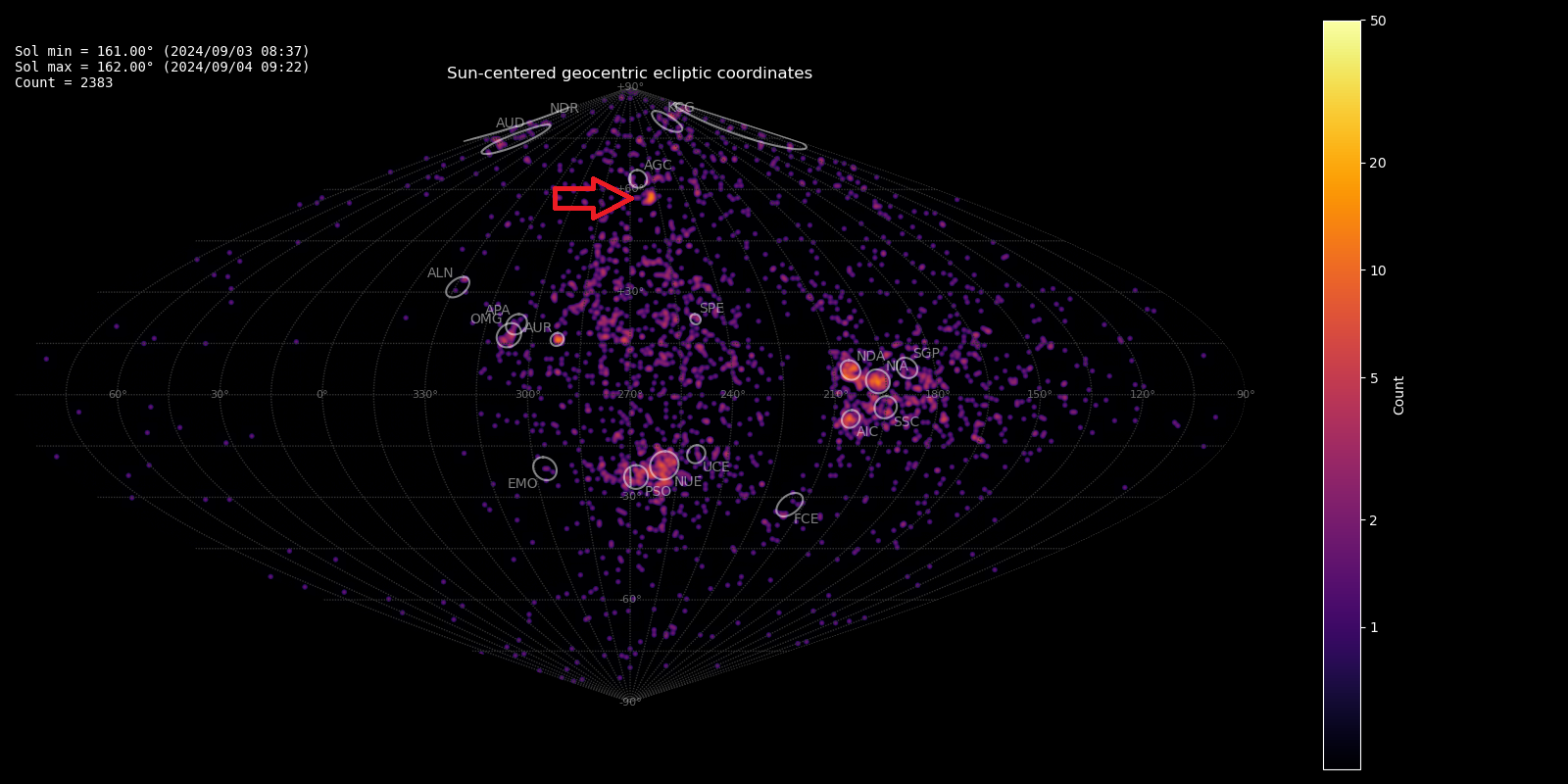
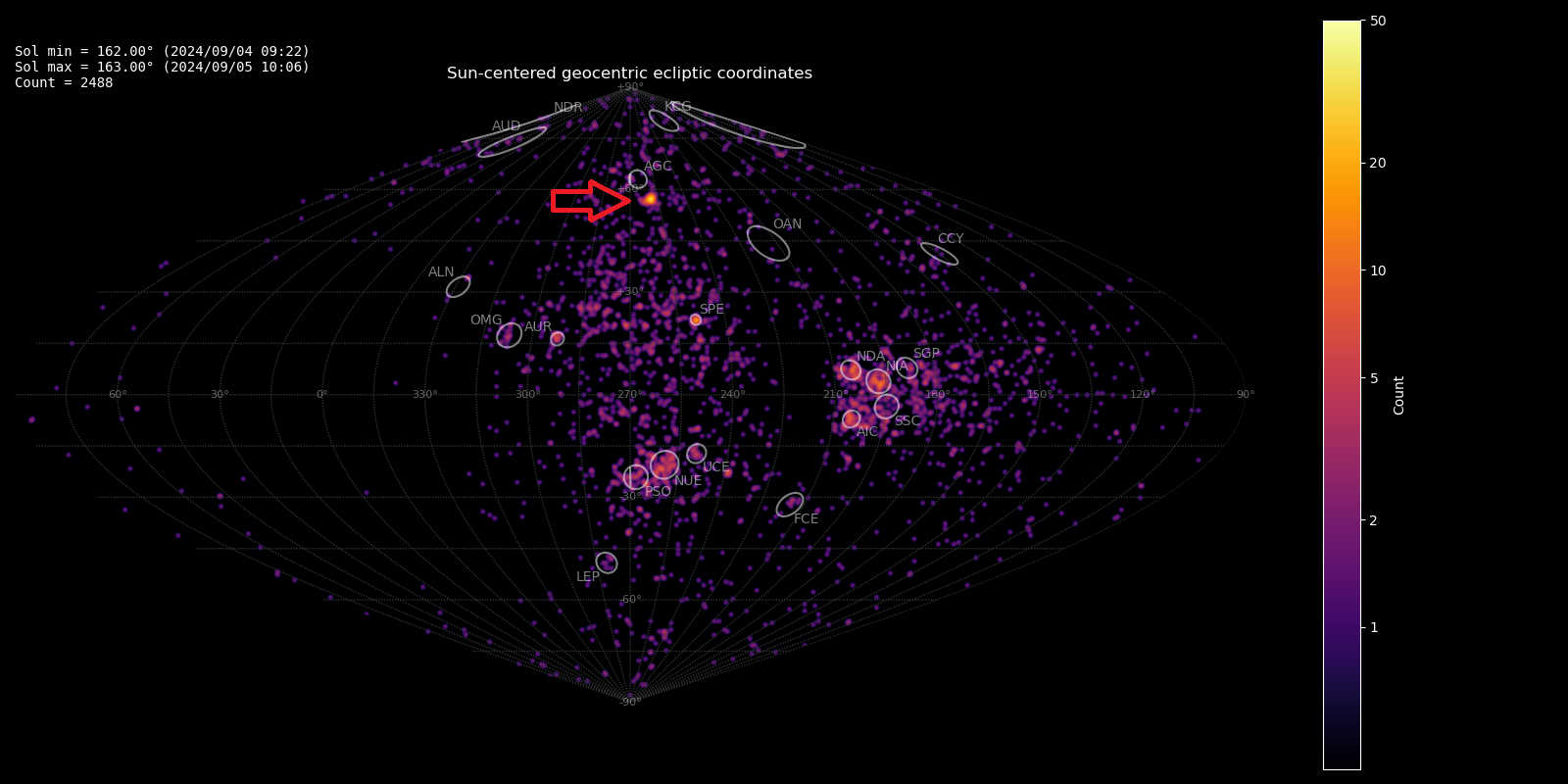
Figure 1 – Radiant plots of the Global Meteor Network data for 2024 September 3–5 in Sun-centered geocentric ecliptic coordinates. The new radiant is visible at high ecliptic altitude and marked by a red arrow.
Extraction of the shower from the background
We used the procedure as described for some recent cases of possibly new showers in Boötes and Draco (Šegon et al., 2023). The Drummond dissimilarity criteria DD has been chosen for the analysis of the new radiant concentration. A first iteration revealed a clear concentration of orbits, as it can be seen on Figure 2. The Rayleigh distribution fit pointed at a DD value of 0.06 as the orbital similarity cutoff (Figure 3), which resulted in 51 orbits representing the possibly new meteor shower.
The presence of non-shower radiants in the area around the possibly new shower (Figure 4) shows the cutoff to be reliable since the density of meteor radiants does not look affected after removing shower members (plotted as pale diamonds). The plot of the shower meteor radiants in equatorial coordinates shows a very compact group, with a standard deviation of the distances from the average radiant position of about a single degree (see Figure 5). The spread in right ascension is due to the high declination. The Π–i diagram shows a compact group of radiants too (Figure 6), without any other groups of radiants to be seen.

Figure 2 – Histogram of the distribution of the Drummond DD criterion values valid for the final mean orbit.

Figure 3 – Rayleigh distribution fit and Drummond DD criterion cutoff.

Figure 4 – All non shower meteor radiants in geocentric equatorial coordinates during the shower activity. The pale diamonds represent the new shower radiants plots, error bars represent two sigma values in both coordinates.

Figure 5 – The reverse of Figure 4, now the shower meteors are shown as circles and the non shower meteors as grayed out diamonds. Note that there are no other groups of meteor radiants to be seen in the vicinity of the possibly new meteor shower.
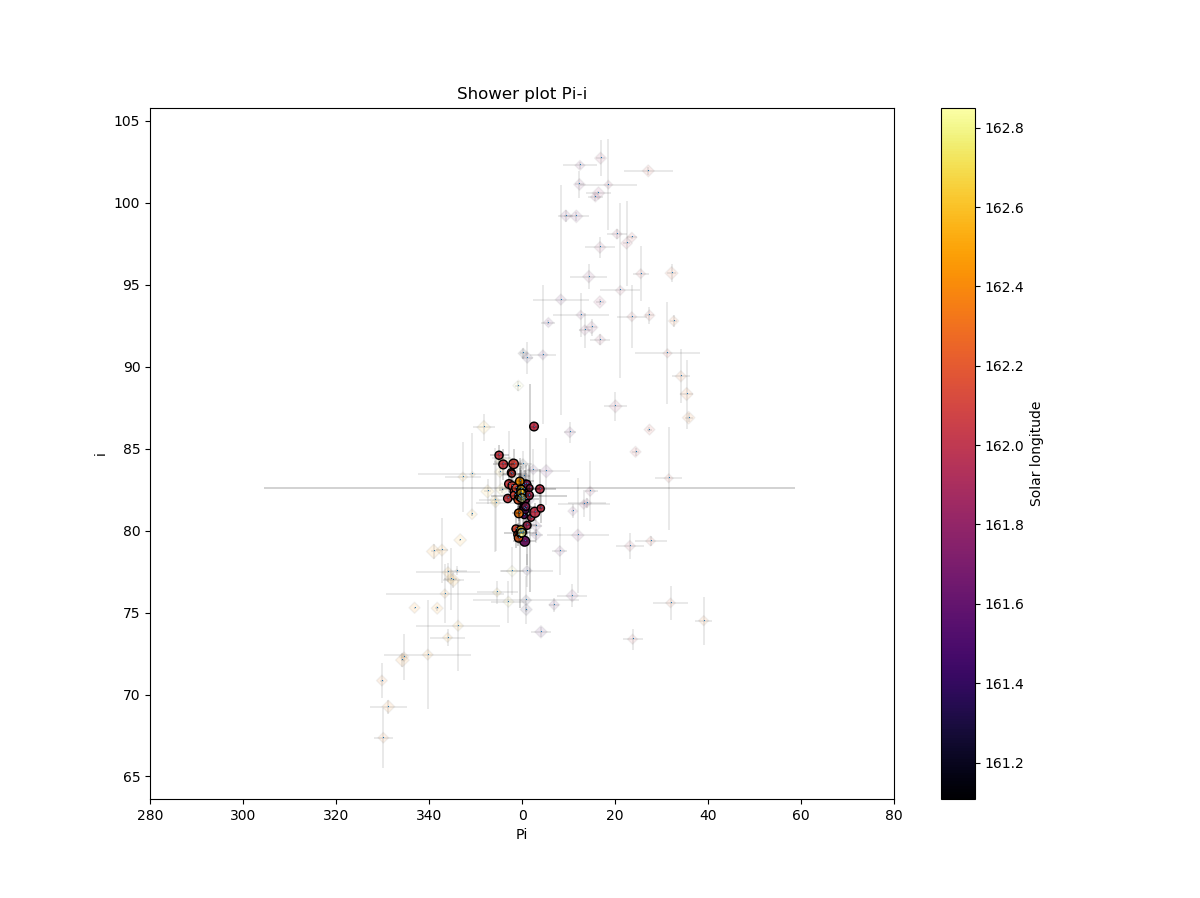
Figure 6 – The diagram of the inclination i against longitude of perihelion Π shows a distinct group of radiants without any other groups to be seen.
The activity period (Figure 7) considered in the first analysis was limited to the interval 161.1° < λʘ < 162.85° (2024, September 3–5) no more related events were detected outside this observing window. The first analysis provided solid proof that a thus far unknown shower had been detected.
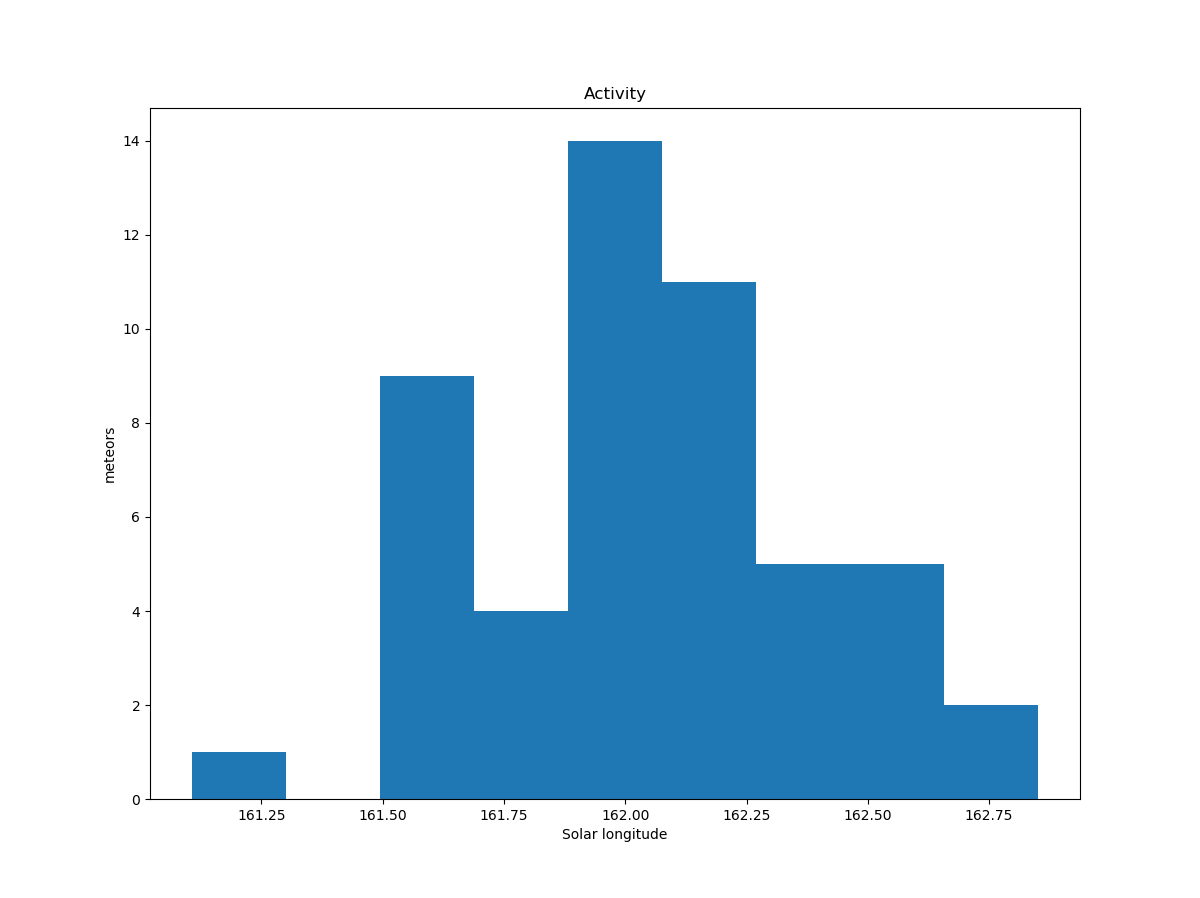
Figure 7 – The activity period with the number of orbits identified as new shower members.
The only nearby meteor shower, August gamma-Cepheids (AGC#0523) has its main activity at solar longitude 155°–156° and its activity period ends at solar longitude 162°. Its orbit has a higher eccentricity and lower inclination and therefore the similarity criteria indicate no connection to the new meteor shower. Some other meteor showers in the neighborhood of the new meteor shower radiant differ even more in activity period and orbit parameters.
Another search method
Another method has been applied to check this new meteor shower discovery. The starting point here can be any visually spotted concentration of radiant points or any other indication for the occurrence of similar orbits. The method has been described before (Roggemans et al., 2019). The main difference with the method applied in Section 2 is that three different discrimination criteria are combined in order to have only those orbits which fit different criteria. The D-criteria that we use are these of Southworth and Hawkins (1963), Drummond (1981) and Jopek (1993) combined. Instead of using a cutoff value for the D-criteria these values are considered in different classes with different thresholds of similarity. Depending on the dispersion and the type of orbits, the most appropriate threshold of similarity is selected to locate the best fitting mean orbit as the result of an iterative procedure.
This method detects 65 candidate orbits with similarity criteria better than DD < 0.06, DSH < 0.15 and DJ < 0.15. The concentration of these radiants (red and yellow dots) is obvious in Figures 8 and 9. Table 1 compares the average orbit parameters obtained by the method of Šegon et al. (2023), listed as GMN (Šegon) with the mean orbit computed according to Jopek et al. (2006) for the selection obtain by the method of Roggemans et al. (2019), listed as GMN (Roggemans) given for the Drummond cutoff DD < 0.06 and for the 23 best matching orbits with DD < 0.02. The dispersion of the radiants with less good similarity (blue and green dots) are also shown in Figures 8 and 9, but these orbits were not used to compute the mean orbit to avoid contamination with sporadics. A few more matching orbits were found before and after the outburst interval, six orbits during the nights before λʘ = 261° and four orbits after λʘ = 263°. These orbits were not used to compute the mean orbit as these may either be dispersed meteoroids from this stream or pure chance matching sporadics. These small numbers are statistically not significant to define a meteor shower activity period. The concentration of the orbits of the newly discovered meteor shower appears very distinctly in the diagrams of the inclination i against the longitude of perihelion Π (Figure 10).
The activity profile (Figure 11) shows a distinct peak activity during the interval 161.8° < λʘ < 162.2° corresponding to roughly 2024, September 04, 09h ± 5h. This explains why most of the orbits were recorded by South Korean and American GMN cameras.
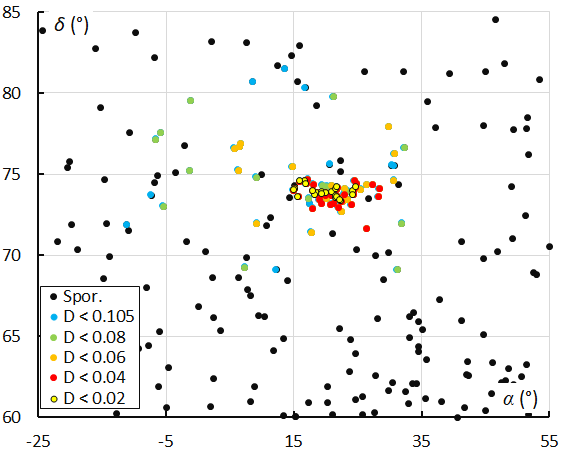
Figure 8 – Radiant plot in geocentric equatorial coordinates for different similarity thresholds.
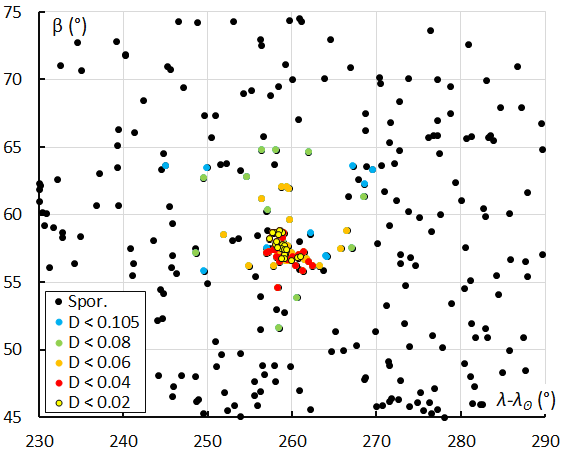
Figure 9 – Radiant plot in geocentric Sun-centered ecliptic coordinates for different similarity thresholds.
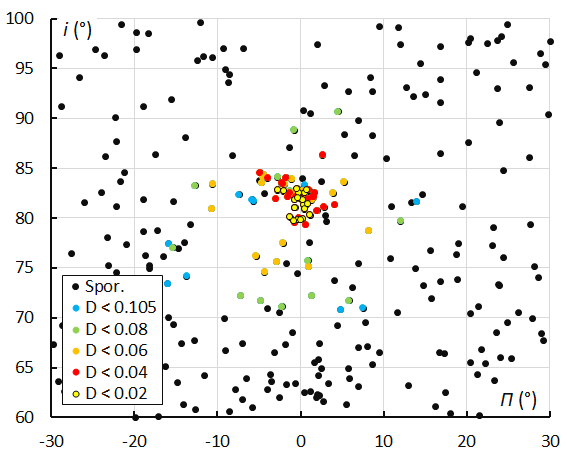
Figure 10 – Diagram of the inclination i against the longitude of perihelion Π.
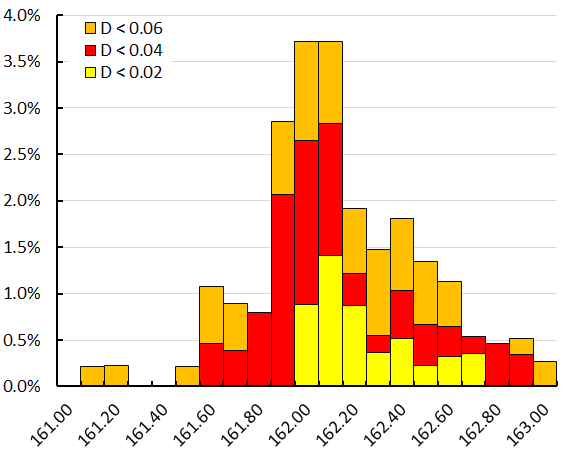
Figure 11 – The activity profile with the percentage of new shower orbits relative to the total number of orbits available during each time interval of 0.2° in solar longitude.
Table 1 compares the GMN results obtained by the two methods with the results published by CAMS and SonotaCo. Note that nine of the 13 orbits used by CAMS were recorded on RMS cameras at Lowell Observatory in Arizona which are also included in the GMN dataset. All results are in very good agreement, although CAMS has a slightly higher velocity resulting in a larger semi major axis a and larger eccentricity e.
Table 1 – The mean orbit for the new meteor shower, derived by two different methods and compared to the results published by CAMS and by SonotaCo. Note that Šegon and Sekiguchi use averaged values while Roggemans and Jenniskens use median values.
| GMN (Šegon) | GMN (Roggemans) | CAMS (Jenniskens) | SonotaCo (Sekiguchi) | ||
| DD < 0.06 | DD < 0.02 | ||||
| λʘ (°) | 161.98 | 162.0 | 162.0 | 162.104 ± 0.005 | 162.198 ± 0.114 |
| λʘb (°) | 161.11 | 161.1 | 161.54 | – | – |
| λʘe (°) | 162.85 | 163.0 | 162.66 | – | – |
| αg (°) | 21.0 ± 3.3 | 20.9 ± 5.4 | 19.9 ± 2.9 | 20.6 ± 0.6 | 23.23 ± 1.94 |
| δg (°) | +73.8 ± 0.5 | +73.9 ± 1.1 | +73.9 ± 0.3 | +73.5 ± 0.2 | 74.04 ± 0.52 |
| Δαg (°) | – | – | – | – | – |
| Δδg (°) | – | – | – | – | – |
| Hb (km) | 106.4 ± 2.0 | 106.3 ± 3.1 | 106.5 ± 1.9 | – | 106.4 |
| He (km) | 92.4 ± 3.0 | 93.0 ± 3.4 | 90.6 ± 3.1 | – | 91.8 |
| vg (km/s) | 45.5 ± 0.8 | 45.4 ± 1.1 | 45.4 ± 0.4 | 46.4 ± 0.3 | 45.30 ± 0.44 |
| λ (°) | 61.2 ± 1.3 | 61.1 ± 2.1 | 60.8 ± 1.0 | – | |
| λg – λʘ (°) | 259.1 ± 1.3 | 259.0 ± 2.1 | 258.9 ± 0.8 | 258.6 ± 0.3 | – |
| βg (°) | +57.3 ± 0.8 | +57.3 ± 1.4 | +57.5 ± 0.7 | +57.2 ± 0.2 | – |
| a (A.U.) | 3.73 ± 0.51 | 3.78 ± 0.66 | 3.74 ± 0.18 | 5.3 ± 0.4 | 3.37 ± 0.33 |
| q (A.U.) | 0.988 ± 0.004 | 0.988 ± 0.006 | 0.988 ± 0.002 | 0.987 ± 0.001 | 0.991 ± 0.004 |
| e | 0.736 ± 0.033 | 0.739 ± 0.040 | 0.736 ± 0.013 | 0.812 ± 0.018 | 0.704 ± 0.029 |
| i (°) | 82.0 ± 1.4 | 81.6 ± 2.2 | 81.5 ± 1.1 | 82.4 ± 0.3 | 82.1 ± 0.5 |
| ω (°) | 197.6 ± 1.7 | 197.2 ± 2.9 | 197.7 ± 0.9 | 197.8 ± 0.5 | 196.76 ± 1.79 |
| Ω (°) | 162.1 ± 0.4 | 162.1 ± 0.4 | 162.0 ± 0.3 | 162.07 ± 0.04 | 162.20 ± 0.11 |
| Π (°) | 359.7 ± 1.7 | 359.3 ± 3.0 | 359.7 ± 0.9 | 359.6 ± 0.5 | 1.71 ± |
| Tj | 1.55 ± 0.18 | 1.54 ± 0.22 | 1.56 ± 0.06 | 1.15 ± 0.10 | 1.71 ± 0.16 |
| λΠ | 344.6 | 344.6 ± 0.8 | 344.8 ± 0.4 | – | 344.57 ±0.34 |
| βΠ | –17.5 | –17.0 ± 2.9 | –17.6 ± 0.9 | – | –16.6 ±1.76 |
| N | 51 | 65 | 23 | 13 | 6 |
In his report on this new meteor shower, Peter Jenniskens wrote: “These meteors have an entry speed below that of most of the sporadic background in that direction”. To visualize this velocity difference, we plotted the diagrams of Sun-centered geocentric coordinates (Figure 12) and inclination i against the longitude of perihelion Π (Figure 13), both color-coded for the geocentric velocity vg. However, no distinct difference in geocentric velocity for the new meteor shower concentration can be seen in these diagrams. The velocities are in the range of what can be expected from this direction.
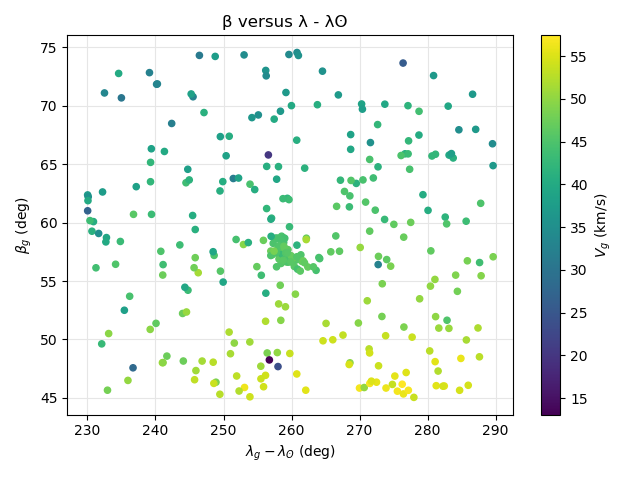
Figure 12 – Diagram of the Sun-centered geocentric longitude λg – λʘ against the geocentric altitude β, color-coded for the geocentric velocity vg.
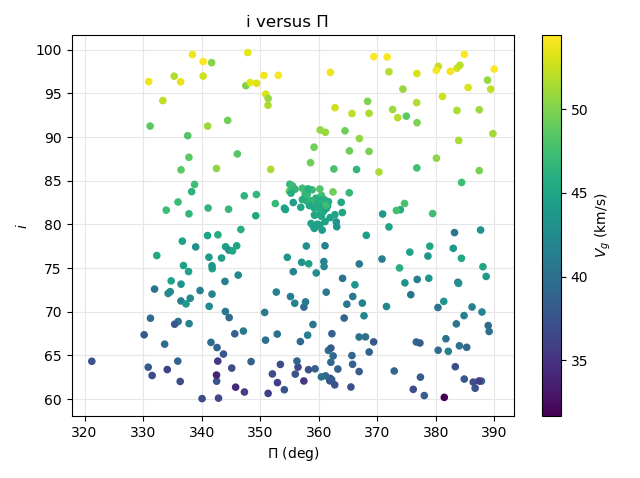
Figure 13 – Diagram of the inclination i against the longitude of perihelion Π, color-coded for the geocentric velocity vg.
Comparing older data and other datasets
Looking up past years orbit data for Global Meteor Network (2018–2023, 1174206 orbits), we find 74 orbits with DD < 0.06. Three (1) in 2019, seven (3) in 2020, 23 (6) in 2021, 18 (6) in 2022 and 23 (4) in 2023, spread over different nights. The number of orbits recorded within the outburst interval of 2024, 162.0° < λʘ < 163.0, is mentioned in brackets. The SonotaCo net orbit data (2007–2023, 490283 orbits) has only 12 orbits with DD < 0.06, recorded in different years. EDMOND (2001–2023, 508266 orbits), has 33 orbits with DD < 0.06 in different years, two in 2010, two in 2011, 3 (1) in 2013, 12 (9) in 2014, eight in 2015 and six in 2016. The CAMS orbit data (2010–2016, 471582 orbits), has 28 orbits with DD < 0.06, seven (3) in 2013, seven (5) in 2014, ten (7) in 2015 and four (2) in 2016.
The shower has been active in past years but the level of activity was too low for the major video camera networks to identify it as a meteor shower. There is some indication that the shower produced some enhanced activity in 2014 according to EDMOND and CAMS data, but beyond the threshold to detect it as a new meteor shower.
Conclusion
The Global Meteor Network provided convincing evidence for the occurrence of a new meteor shower outburst on 2024 September 4. The Tisserand relative to Jupiter with TJ = 1.55 suggests a Mellish type cometary orbit. Past observations indicate some weak annual activity with an indication for a possible earlier outburst in 2014. The new meteor shower has been reported on behalf of the Global Meteor Network to the IAU MDC for inclusion in the Working List of Meteor Showers.
Acknowledgment
This report is based on the data of the Global Meteor Network (Vida et al., 2020a; 2020b; 2021) which is released under the CC BY 4.0 license. We thank all 825 participants in the Global Meteor Network project for their contribution and perseverance. This list of operators whose cameras provided the data used in this work and contributors who made important code contributions are mentioned elsewhere in this issue (Šegon et al., 2025).
References
Drummond J. D. (1981). “A test of comet and meteor shower associations”. Icarus, 45, 545–553.
Jenniskens P., Moskovitz N. (2024a). Meteor shower outburst with radiant in Cassiopeia. CBET 5442. Ed. D. W. E. Green. IAU Central Bureau for Astronomical Telegrams. 1 pp.
Jenniskens P., Moskovitz N. (2024b). “2024 outburst of September psi-Cassiopeiids”. eMetN Meteor Journal, 9, 397-399.
Jopek T. J. (1993). “Remarks on the meteor orbital similarity D-criterion”. Icarus, 106, 603–607.
Jopek T. J., Rudawska R. and Pretka-Ziomek H. (2006). “Calculation of the mean orbit of a meteoroid stream”. Monthly Notices of the Royal Astronomical Society, 371, 1367–1372.
Jopek T. J., Jenniskens P. M. (2011). “The Working Group on Meteor Showers Nomenclature: A History, Current Status and a Call for Contributions”. In, W.J. Cooke, D.E. Moser, B.F. Hardin, and D. Janches, editors, Meteoroids: The Smallest Solar System Bodies, Proceedings of the Meteoroids Conference held in Breckenridge, Colorado, USA, May 24-28, 2010. NASA/CP-2011-216469, pages 7–13.
Jopek T. J., Kaňuchová Z. (2014). “Current status of the~IAU MDC Meteor Showers Database”. In, T.J. Jopek, F.J.M. Rietmeijer, J. Watanabe, I.P. Williams, editors, Meteoroids 2013 Proceedings of the Astronomical Conference held at A.M. University, Poznan, Poland, Aug. 26-30, 2013, A.M. University Press, pages 353–364.
Jopek T. J., Kaňuchová Z. (2017). “IAU Meteor Data Center-the shower database: A status report”. Planetary and Space Science, 143, 3–6.
Neslušan L., Poručan V., Svoreň J., Jakubík M. (2020). “On the new design of the IAU MDC portal”. WGN, Journal of the International Meteor Organization, 48, 168–169.
Roggemans P., Johannink C. and Campbell-Burns P. (2019a). “October Ursae Majorids (OCU#333)”. eMetN Meteor Journal, 4, 55–64.
Šegon D., Vida D., Roggemans P. (2023). “New meteor shower in Draco”. eMetN Meteor Journal, 8, 171–176.
Šegon D., Vida D., Roggemans P. (2025). “New meteor shower in Ursa Minor”. eMetN Meteor Journal, 10, xxx–xxx.
Sekiguchi T. (2024). “2024 outburst of September psi-Cassiopeiids by SonotaCo Network in Japan”. eMetN Meteor Journal, 9, 400-403.
Southworth R. B. and Hawkins G. S. (1963). “Statistics of meteor streams”. Smithsonian Contributions to Astrophysics, 7, 261–285.
Vida D., Gural P., Brown P., Campbell-Brown M., Wiegert P. (2020a). “Estimating trajectories of meteors: an observational Monte Carlo approach – I. Theory”. Monthly Notices of the Royal Astronomical Society, 491, 2688–2705.
Vida D., Gural P., Brown P., Campbell-Brown M., Wiegert P. (2020b). “Estimating trajectories of meteors: an observational Monte Carlo approach – II. Results”. Monthly Notices of the Royal Astronomical Society, 491, 3996–4011.
Vida D., Šegon D., Gural P. S., Brown P. G., McIntyre M. J. M., Dijkema T. J., Pavletić L., Kukić P., Mazur M. J., Eschman P., Roggemans P., Merlak A., Zubrović D. (2021). “The Global Meteor Network – Methodology and first results”. Monthly Notices of the Royal Astronomical Society, 506, 5046–5074.

